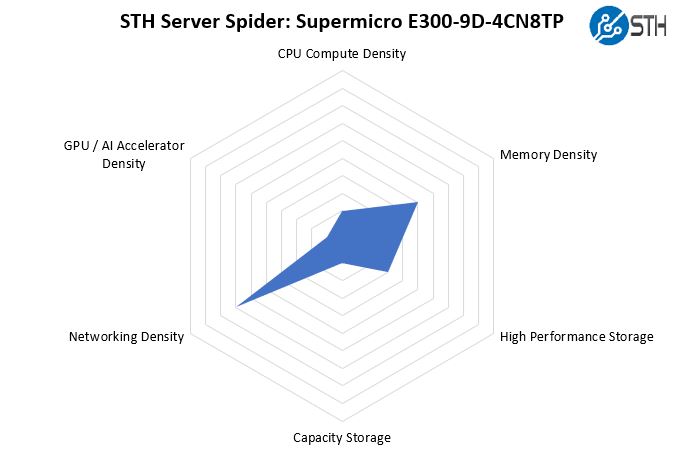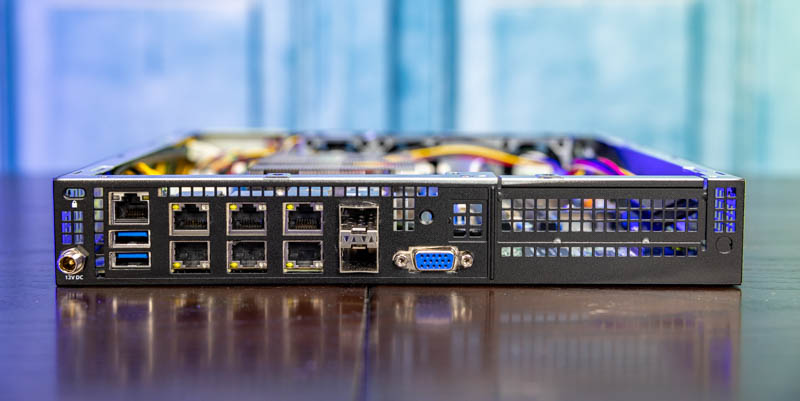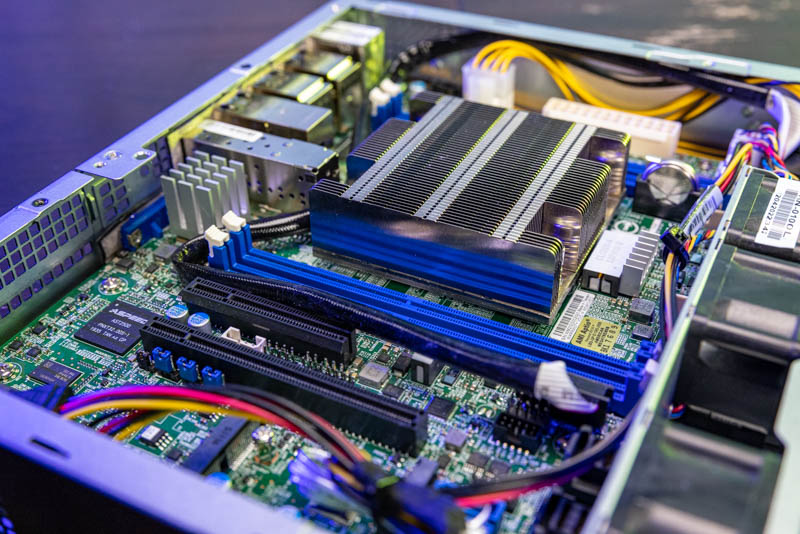Power Consumption
Here are a few key stats we recorded with the system equipped with 4x 32GB DDR4-2400 and an Intel DC S3710 400GB SSD.
- Idle: 51.3W
- 60% Load (non-AVX): 82.6W
- AVX-512 GROMACS Load: 99.28W
We held these workloads for 20 minutes in a 17.1C data center with 55% RH on 208V power. Note, these are slightly outside of where we normally take measurements and on a shorter duration interval. At the same time, we wanted to get information out as soon as possible.
We are just going to note that that noise is perhaps the weak point of this system. It is loud at boot which is acceptable. The power supply does not have a fan so it is relatively quiet. The three 1U fans are quiet enough at idle but the fans ramp under load to the point where this system should be kept in an equipment closet or somewhere that does not have a relatively low noise floor.
STH Server Spider
In the second half of 2018, we introduced the STH Server Spider as a quick reference to where a server system’s aptitude lies. Our goal is to start giving a quick visual depiction of the types of parameters that a server is targeted at.

This is an interesting case. This system has solid networking connectivity. There are CPU options that are 16 cores and therefore much higher compute density in this form factor. In terms of memory density, 512GB is less than a mainstream 1U server, but quite a lot for a compact edge system like this. There are a number of storage options onboard, but one is ultimately limited to the chassis dimensions and how much storage can be placed in such as small volume.
Final Words
Overall, this is a great platform. The compact size and eight network ports using higher-end Intel NIC IP are great. One has access to 4x 1GbE and 4x 10GbE (2x SFP+/ 2x 10Gbase-T) onboard which is far beyond what many edge platforms offer as standard, and one can optionally add features such as WWAN support and even a low-profile PCIe card.

Perhaps the biggest feature though is the Intel Xeon D-2100 platform. This uses platform I/O IP from the Intel Lewisburg family which means support for the Xeon D-2100 series is excellent, mirroring the high-volume Intel Xeon Scalable server platforms for almost four years.
At around $850-900 street price (barebones) that is around a $200 premium over the bare motherboard and comes pre-assembled. This includes the Intel Xeon D-2123IT and with all of the networking onboard one can add RAM and a 2.5″ SATA/ M.2/ SATADOM/ mPCIe for a boot drive and have a system ready to go. It would cost more to assemble a system with the Xeon D-2123IT using lower-end onboard networking and then adding a dual 10Gbase-T NIC for example. While this is not the least expensive platform, it does provide good value if one needs higher-end networking.

Supermicro did an excellent job overall with the E300-9D-4CN8TP. We wish it could be a bit quieter, but the Xeon D-2100 series uses higher-power CPUs and this is a small chassis. Trade-offs had to be made in terms of expandability and overall Supermicro did a great job making the trade-offs on this platform.




Thank You for your solid review of my dream motherboard! Yes, I am one of those Supermicro X11SDV-4C-TP8F fanboys;). Best Regards, ABQ :)
I know as the readers of STH we do not like that STH is now doing video, but the video for this one is like a doctoral dissertation on this system and the current state of the Xeon D-2100 series.
I’d say you should make the Xeon D insight around pricing from the video its own article. That’s a stinger in the video.
Anyone that has one and can comment on how picky this system is regarding SFP+ optics/DAC? I have the previous generation and with most Intel drivers these started requiring Intel coded DACs halfway through their lifecycle, causing major issues when this happened after scheduled updates on devices in the field.
Intel forgot to put a QAT in this processor :)
Not great for IPSEC, openssl and crypto workloads.
VPNs are quite popular in 2021.
But they offer nice xeon-d models with hardware crypto acceleration.
The Supermicro SuperServer E300-9D-8CN8TP has some distinct advantages. The E300-9D-8CN8TP sports an Intel® Xeon® D-2146NT, which has Intel Quick Assist Technology. The reviewed Supermicro SuperServer E300-9D-4CN8TP sports the more limited Intel® Xeon® D-2123IT, which lacks Intel QAT. The E300-9D-8CN8TP adds 4C and a sizeable $500 on Amazon. An alternative might be to add an Intel QAT accelerator, but there would need to be available power and you’d lose the PCIe slot. Used Intel QAT accelerators are available on eBay for cheap.
it’s seems a great option for home server but for 8-900 $ it’s to high
The Supermicro X11SDV-4C-TP8F motherboards are $449 NIB & free shipping, if you already have a case.
@Fred Tang: I am a long-time reader too and enjoy the videos.. So it is not all of us.
I was sceptic at first, but it provides additional value and is not just the article script in video form.
I urge other video sceptics to give it a try!
And to the die-hard anti-video crowd: Any tech journalist knows, that without YouTube, traditional online journalism is dead as disco. It is a matter of survival, plain and simple.
@ABQ Supermicro X11SDV-4C-TP8F in italy is over 700€ on ebay 500$ plus 2-300$ of duties
usa’s price is very differente for europeans people for costums duties and VAT (in italy is 22%)
BMC/IPMI licenses are BS, which is why I’m happy purchasing Gigabyte/ASrock Rack.
I’m running 2 of these for 2 Years 7/24 now without any Problems. Perfect for a VMWARE Home-Lab, but not only. I’ve replaced the (loud) Stock Fan’s with Noctua Fan’s – they are not so loud and cools good (Noctua NF-A4x20 PWM). Also added the RSC-RR1U-E8 expansion for the low Profile Riser Card (AOC-SLG3-2M2-O), so you can run 2 additional M.2 NVMe SSDs. Perfect for running/testing VSAN (Robo). As i was so satisfied with this Supermicro-Solution i run now 2 additional 8-Core Versions of this Barebones (E300-9D-8CN8TP) for running/testing “remote-site replication” scenarios. I can only recommend this Barebones.
Hi Giuse! Did you replace the fans of the E300 chassis with Noctua fans? Are you happy with them? Did it get silent?
Hi Giuse! greeting,
do you run E300-9D-4CN8TP or E300-9D-8CN8TP,
I’m looking for my expansion of 2x for workload home lab (VMware SDDC Stack) on E300-9D-8CN8TP?
do you advice for the same.
SYS-E300-9D-8CN8TP
Release Date: Nov 2018 (EOL: Q1 2025)
CPU: Intel Xeon D-2146NT (8c/16t)
Memory: 512GB
Storage: 1 x M.2 (Additional 1 x M.2 possible with PCIe Add-in-Card or 2 x M.2 possible with AOC-SLG3-2M2)
Max Devices: 3
Network: 2 x 10GbE, 2 x 10GbE (SFP+), 4 x 1GbE, 1 x 1GbE (IPMI)
VMware HCL: Yes (supports up to vSphere 7.0 Update 1)
which one you recommend:
1-https://www.amazon.com/gp/product/B07JN5T2RT/ref=ox_sc_saved_title_6?smid=AEELF2HAVZFED&psc=1
2-https://www.amazon.com/gp/product/B07RCN114X/ref=ox_sc_saved_title_5?smid=ATVPDKIKX0DER&psc=1